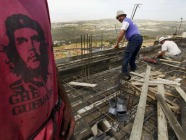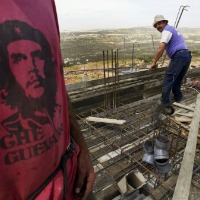
Last week, my colleagues in the Israeli Peace Now movement issued two blockbuster reports. These weren't the regular "more construction was announced" fare. These reports have huge implications, both negative and positive, for peace and the two-state solution.
The Bad News: Settlement Construction Surges, Even Without Tenders
Peace Now documented a 70 percent increase in new
construction starts in settlements during the first six months of 2013, as compared to the same period in 2012.
That's in addition to a huge number of units completed or on which work was ongoing during this period--altogether
translating to 3,070 units which are or will soon be available to house new settlers. Assuming a family of five,
this translates to around 15,000 new settlers.
What is perhaps most striking about this construction surge is that it occurred during what most people thought was
a quasi-freeze in West Bank settlement projects. Why did people think that? Because earlier this year, in an
ostensible sign of seriousness about peace negotiations, Israel Prime Minister Benjamin Netanyahu promised
to stop issuing tenders for settlement construction. The catch--which few understood--was that under current
Israeli planning rules, a great deal of settlement construction doesn't require tenders. In this manner, fully 86
percent of the construction started between January and June 2013 went ahead without any tenders needed.
In short, Netanyahu had his cake and ate it too. He got credit from the U.S. and international community for
showing "restraint" by voluntarily refraining from issuing new tenders for the first half of 2013, while allowing
settlement construction to swell on his watch.
This little-known settler-friendly idiosyncrasy of Israel's building regulations is even more important given
last week's news that a top aide to Netanyahu
is pushing to change West Bank construction rules, such that ALL construction in settlements can proceed without
tenders. Haaretz, commenting on the plan, explains succinctly: "The goal is to reduce the diplomatic pressures that
results from publicizing such tenders."
Some might retort, given the construction trends detailed in the latest Peace Now report, what's the difference? In
fact, the difference is huge. Construction in 33 settlements still requires tenders, including in the planned
settlements of E-1, and in major settlements like Ariel, Efrat, and Maale Adumim. Make no mistake: a decision by
the government of Israel to relinquish wholesale authority over settlement construction to the settlement
municipalities is an ideologically-motivated sleight-of hand, tantamount to a formal green light for unrestrained
settlement expansion. And when this expansion takes place, Israeli officials clearly anticipate telling the world,
"sorry, there's nothing we can do--it's out of our hands."
The reality is that construction in settlements is never out of Israeli government hands. Where tenders are
required, the government can prevent construction by simply refraining from issuing tenders. Where tenders are not
required (not by some immutable law of nature, but by Israeli regulations designed to favor settlement growth) it
can actively intervene to freeze construction. The latter course of action is, without question, more politically
costly for any Israeli government. The day all settlement construction falls into this latter category, Israeli
officials no doubt hope that pressure to curb settlements will quietly die, much like the U.S. demand for a
settlement freeze died following Israeli government game-playing during the peace effort led by Special Envoy
George Mitchell.
That's the bad news--and it will be much worse news if the government puts into effect plans to change the way
settlement construction is approved. This is something the international community should be paying close attention
to, and protesting loudly. The Peace Now report sounds this important alarm.
The Good News: Settlements Haven't Killed the Two-State Solution
In a separate report, Peace Now examines the settlement enterprise
since the Oslo Accords. Its findings are far more encouraging than the "it's-too-late-for-two-states" crowd
would have people believe. Peace Now concludes, based on the data, that: "The settlements may have destroyed trust
between the sides but, they have not destroyed the two-state solution."
True, the number of settlers has tripled since the Oslo Accords were signed in 1993. However, details matter, and
Peace Now highlights a key detail: most of the increase in settlers (64 percent) has been confined to settlements
that could become part of Israel in a two-state agreement (you can see a map of the post-Olso population growth
here). Indeed,
half of the post-Oslo population growth has been focused in three settlements (Modi'in Illit, Beitar Illit, and
Maale Adumim). To be clear, we know what a realistic vision of a negotiated two-state agreement looks like, because
we have the Geneva Initiative
model. Today, settlers living outside the lines negotiated in that model represent only 1.8 percent of the
Israeli population.
Another important detail uncovered by Peace Now is that, broadly speaking, non-ideological Israelis, be they
secular or religious, have refused to buy into the ideological settlers' plans. Take, for example, the settlement
of Immanuel, located deep inside the West Bank, southeast of Nablus. Immanuel was established with a plan to become
an ultra-Orthodox city of tens of thousands. Pre-Oslo, Immanuel had 3,240 residents; today its population has
declined to 3,013. Apparently the truism, "if you build it [or plan it], they will come" doesn't apply when it
comes to attracting non-ideological settlers to the West Bank heartland. In contrast, Beitar Illit and Modi'in
Illit, located close to the Green Line, have been magnets for ultra-Orthodox Israelis, not for reasons of ideology,
but based on geographic convenience and economic attractiveness.
Or take the settlement of Ariel, located smack-dab in the middle of the northern West Bank. Ariel was planned to be
a large, secular Israeli city with tens of thousands of residents. Things haven't worked out as planned. In the 20
years since Oslo, Ariel's population has grown only from 11,800 to 18,100--making Ariel not a large Israeli city
but akin to a small town inside the Green Line (and this, despite huge Israeli government financial and political
investment in Ariel, including accrediting the settlement's college as a full university--a move that may well have
been the immediate catalyst for the EU's recent settlement directive). Likewise, the situation of Jordan Valley
settlements and other non-ideological isolated settlements in the West Bank is a similar story of failure. Since
Oslo, the populations of such settlements have continued to decline each year.
All of this is good news, but by no means reason for complacency. Peace Now's report concludes with both
encouragement and a warning:
"The settlers have failed in their attempt to create irreversible facts on the ground that would prevent the establishment of a Palestinian state. In recent years, under the previous and current Netanyahu governments, there has been an attempt to change that picture by developing more isolated areas and building projects precisely in the areas that will undermine the two-state option. The more time that the government and settler movement has free reign to build and develop isolated areas, the more difficult a two-state solution will become. Twenty years after Oslo, they have not won, but the fight for the two-state solution must remain vigilant and determined."
Now the question is whether or not that warning will be heeded.
This article appeared first on October 21,
2013 at Open Zion
